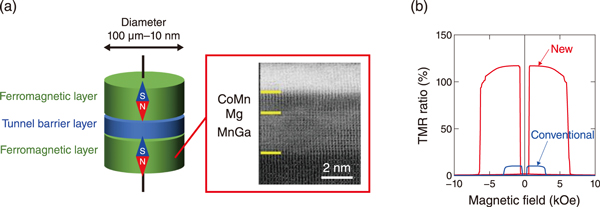
Fig.1 (a) Cross-sectional transmission electron microscopy image of the newly developed multilayer electrode and (b) the magnetic field dependence of the electrical resistance of tunnel magnetoresistance (TMR) devices
When a voltage is applied to a three-layered film consisting of a thin insulator film (tunnel barrier layer) sandwiched between thin metal films, electrons pass through the insulator film. This effect is called the quantum tunneling effect. When a magnetic metal is used in a thin metal film, the magnitude of the current flow depends on the difference in the combination of the N and S poles of the two magnets. Tunnel magnetoresistance (TMR) devices based on the TMR effect (Fig.1(a)) are already used in our daily lives in the form of magnetic heads in hard disk drives, magnetoresistive memory, and magnetic sensors. They are also expected to find applications in the nuclear and aerospace industries because of their radiation resistance.
In this research, tetragonal a manganese gallium (MnGa) alloy was explored as a new magnetic material for building TMR elements (Fig.1). This magnetic material is known as a perpendicularly magnetized material, in which the magnetization (i.e., magnetic polarization) is perpendicular to the film surface. Tetragonal MnGa alloys offer more attractive properties than conventional magnetic materials and can improve the performance and functionality of future TMR devices. However, the technical challenge for MnGa-based TMR devices is that the tunnel magnetoresistance ratio (TMR ratio), which represents the magnitude of the TMR effect, is low−only a few per cent.
In this research, we developed a new hybrid magnetic electrode consisting of an MnGa layer, a magnesium (Mg) layer, and a cobalt manganese alloy (CoMn) layer (Fig.1(a)). This electrode was prepared by a precise thin-film fabrication process with the extremely thin regions comprising a few atomic layers. Consequently, a TMR ratio of about 120% was achieved at room temperature; this TMR is more than 10 times that of the conventional devices (Fig.1(b)). Our achievement will promote the development of TMR devices that leverage the excellent magnetic properties of MnGa alloys to achieve significant progress towards industrial applications.
This work was supported in part by JST Adaptable and Seamless Technology transfer Program through Target-driven R&D (A-STEP) Grant Number (JPMJTM20K5), “Development of a Magnetic Sensor with High Coercivity, High TMR and Noble Metal-Free Perpendicularly Magnetized Fixed Layers.”
(Kazuya Suzuki)